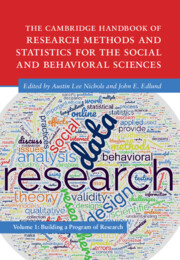 The Cambridge Handbook of Research Methods and Statistics for the Social and Behavioral Sciences
The Cambridge Handbook of Research Methods and Statistics for the Social and Behavioral Sciences from Part IV - Statistical Approaches
Published online by Cambridge University Press: 25 May 2023
Structural equation modeling (SEM) is a family of statistical techniques and methods for testing hypotheses about causal effects among observed or proxies for latent variables. There are increasing numbers of SEM studies published in the research literatures of various disciplines, including psychology, education, medicine, management, and ecology, among others. Core types of structural equation models are described, and examples of causal hypotheses that can be tested in SEM are considered. Requirements for reporting the results of SEM analyses and common pitfalls to avoid are reviewed. Finally, an example of evaluating model fit is presented along with computer syntax so that readers can reproduce the results.
To save this book to your Kindle, first ensure [email protected] is added to your Approved Personal Document E-mail List under your Personal Document Settings on the Manage Your Content and Devices page of your Amazon account. Then enter the ‘name’ part of your Kindle email address below. Find out more about saving to your Kindle.
Note you can select to save to either the @free.kindle.com or @kindle.com variations. ‘@free.kindle.com’ emails are free but can only be saved to your device when it is connected to wi-fi. ‘@kindle.com’ emails can be delivered even when you are not connected to wi-fi, but note that service fees apply.
Find out more about the Kindle Personal Document Service.
To save content items to your account, please confirm that you agree to abide by our usage policies. If this is the first time you use this feature, you will be asked to authorise Cambridge Core to connect with your account. Find out more about saving content to Dropbox.
To save content items to your account, please confirm that you agree to abide by our usage policies. If this is the first time you use this feature, you will be asked to authorise Cambridge Core to connect with your account. Find out more about saving content to Google Drive.